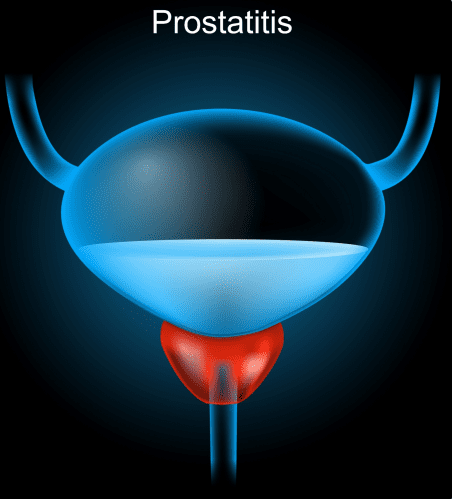Understanding Prostatitis: Symptoms, Causes, and Effective Treatment Options

What Is Prostatitis?
Prostatitis is an inflammation of the prostate gland — a small walnut-shaped organ in men that produces seminal fluid. This condition can cause pain, urinary problems, and sexual dysfunction, affecting men of all ages, though it’s most common between ages 30 and 50.
Prostatitis isn’t a single disease but a group of conditions with different causes and symptoms. It can develop suddenly (acute) or persist over time (chronic). Some cases are caused by bacterial infections, while others occur without any detectable infection. Regardless of the type, timely diagnosis and treatment are key to relief and recovery.
Types of Prostatitis
Doctors classify prostatitis into four main categories:
-
Acute Bacterial Prostatitis
A sudden bacterial infection of the prostate that causes severe symptoms like fever, chills, and painful urination. It requires immediate medical attention. -
Chronic Bacterial Prostatitis
A recurring infection of the prostate gland that comes and goes over months or years. -
Chronic Prostatitis / Chronic Pelvic Pain Syndrome (CP/CPPS)
The most common form, where inflammation and pelvic pain occur without detectable infection. The cause may be nerve irritation, muscle tension, or previous infections. -
Asymptomatic Inflammatory Prostatitis
In this type, inflammation is present but causes no noticeable symptoms. It’s often discovered incidentally during testing for other conditions.
Common Causes of Prostatitis
Prostatitis can have several possible causes depending on its type. The most common include:
-
Bacterial infection — Caused by bacteria entering the prostate from the urinary tract.
-
Nerve damage — Previous pelvic injuries or surgeries may affect the prostate area.
-
Immune system disorders — Autoimmune conditions can cause inflammation.
-
Stress and muscle tension — Chronic stress can tighten pelvic muscles, worsening pain.
-
Urinary reflux — When urine flows backward into the prostate ducts.
Understanding the underlying cause helps in determining the most effective treatment plan.
Symptoms of Prostatitis
The symptoms of Prostatitis vary based on its type and severity but often include:
-
Pain or burning sensation while urinating
-
Difficulty starting or maintaining urine flow
-
Frequent or urgent need to urinate, especially at night
-
Pain in the lower abdomen, groin, or lower back
-
Painful ejaculation or sexual dysfunction
-
Fever, chills, and fatigue (in acute cases)
These symptoms can significantly impact a man’s quality of life. Early diagnosis ensures faster relief and prevents chronic complications.
Diagnosing Prostatitis
Proper diagnosis begins with a thorough medical history and physical exam. Common tests include:
-
Urine tests – To check for bacterial infection or inflammation.
-
Prostate fluid analysis – Helps identify infection directly in the prostate.
-
Blood tests – Detect infection and check prostate-specific antigen (PSA) levels.
-
Imaging (Ultrasound or MRI) – Provides detailed views of the prostate and urinary tract.
Doctors may also perform a digital rectal exam (DRE) to assess the size, texture, and tenderness of the prostate gland.
Treatment Options for Prostatitis
Treatment depends on whether prostatitis is bacterial or non-bacterial and how severe the symptoms are. Here are the most common approaches:
1. Antibiotic Therapy
For bacterial prostatitis, antibiotics are the main treatment. The duration may range from a few weeks to several months, depending on the infection’s severity.
2. Alpha Blockers
These medications help relax the muscles around the prostate and bladder neck, easing urinary flow and reducing pain.
3. Anti-Inflammatory Medication
Pain relievers and anti-inflammatory drugs help manage discomfort and swelling.
4. Lifestyle Changes
Simple steps like increasing water intake, avoiding caffeine and alcohol, and managing stress can greatly improve symptoms.
5. Physical Therapy
Pelvic floor therapy helps relax tense muscles and reduce chronic pelvic pain.
6. Minimally Invasive Procedures
In resistant cases, procedures to improve urinary flow or drain the prostate may be considered.
Living with Prostatitis
Living with Prostatitis can be challenging, especially when symptoms become chronic. Men may experience fatigue, anxiety, and sexual difficulties, affecting both physical and emotional well-being.
Adopting healthy habits can support recovery and prevent recurrence:
-
Drink plenty of water to flush bacteria from the urinary system.
-
Limit spicy foods, alcohol, and caffeine that irritate the bladder.
-
Practice stress management through relaxation or exercise.
-
Follow medical advice and complete prescribed medications.
Regular follow-ups with a urologist help ensure the condition remains under control and doesn’t progress into chronic discomfort.
The Importance of Early Evaluation
Ignoring symptoms like pelvic pain or painful urination can lead to serious complications such as abscess formation, infertility, or chronic urinary problems. Early evaluation and proper treatment ensure faster recovery and prevent long-term issues.
Advancements in urology now make it possible to diagnose and treat prostatitis effectively using non-invasive and targeted approaches. Patients can achieve lasting relief with personalized care from specialists who understand the condition’s complexity.
Conclusion
Prostatitis is a common yet often misunderstood condition that can affect men at any age. While it may cause discomfort, the good news is that effective treatments are available once the root cause is identified. Recognizing symptoms early and consulting a qualified urologist can make all the difference in achieving relief and preventing recurrence.
For expert evaluation and personalized treatment, Urology Partners of North Texas provides comprehensive care for men suffering from Prostatitis and related urinary issues. Their team uses advanced diagnostics and evidence-based therapies to help patients find lasting relief and restore their quality of life.
Frequently Asked Questions (FAQs)
1. What is the main cause of Prostatitis?
Most cases result from bacterial infections or inflammation due to stress, nerve injury, or immune responses.
2. Can Prostatitis go away on its own?
Mild cases may improve with rest and hydration, but most require medical treatment to prevent recurrence or complications.
3. Is Prostatitis contagious?
No, prostatitis is not contagious. However, sexually transmitted infections (STIs) can sometimes lead to prostate inflammation.
4. How is Prostatitis different from an enlarged prostate (BPH)?
While both affect the prostate, Prostatitis is an inflammation or infection, whereas BPH is a non-cancerous enlargement common in older men.
5. How can I prevent Prostatitis?
Drink plenty of water, practice good hygiene, avoid prolonged sitting, and treat urinary infections promptly to reduce risk.






